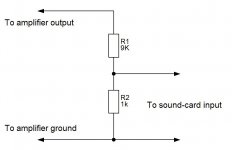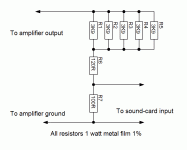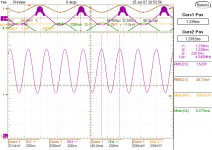ashok said:"
Simplest method is to get a 10 K potmeter . I use a 10 K , 10 turn Bourns pot for this . Start the pot from zero everytime you measure . However the safest method would be to build a battery powered buffer amp with an opamp ( OPA2134 ?) that will make sure you cannot blow up the input of the sound card.
Do a Google and you should come across such a circuit.
The 10 turn pot method is simple and safe if you are careful.
Cheers.
Ashok
Are you sure the output of a 150-200W power amp can be connected to a buffer amp?
Hari
Hi,
peak voltage from a 200W into 8r0 is about 56Vpk
peak current into 10k pot is about 56/10k=5.6mApk.
the maximum (peak) dissipation in the pot is 56*56/10000=0.31W.
the smaller pots can usually accept upto 400mW.
One could preceed the pot with a 22k resistor to reduce the maximum output from the pot, if you think you are clumsy with the pot setting. You decide.
peak voltage from a 200W into 8r0 is about 56Vpk
peak current into 10k pot is about 56/10k=5.6mApk.
the maximum (peak) dissipation in the pot is 56*56/10000=0.31W.
the smaller pots can usually accept upto 400mW.
One could preceed the pot with a 22k resistor to reduce the maximum output from the pot, if you think you are clumsy with the pot setting. You decide.
AndrewT said:Hi,
peak voltage from a 200W into 8r0 is about 56Vpk
peak current into 10k pot is about 56/10k=5.6mApk.
the maximum (peak) dissipation in the pot is 56*56/10000=0.31W.
the smaller pots can usually accept upto 400mW.
One could preceed the pot with a 22k resistor to reduce the maximum output from the pot, if you think you are clumsy with the pot setting. You decide.
Andrew
I get your point. The pot and the 22K resistor would form a kind of an external attenuator.
Would I be right in assuming that this attenuator will only reduce the amplitude of the signal coming out of the power amp and will not mask clipping or any other distortions in the signal?
Following on from Quasi's suggestion 1k0 0.1% and 9k1 0.1%//820k 1% will give 0.1 attenuation (-20db) +-0.1%.
But the measuring instrument across the 1k0 must have a high impedance. 1M0 adds another 0.1% error, although you can add this back in, once you know it exists.
But the measuring instrument across the 1k0 must have a high impedance. 1M0 adds another 0.1% error, although you can add this back in, once you know it exists.
AndrewT said:Following on from Quasi's suggestion 1k0 0.1% and 9k1 0.1%//820k 1% will give 0.1 attenuation (-20db) +-0.1%.
But the measuring instrument across the 1k0 must have a high impedance. 1M0 adds another 0.1% error, although you can add this back in, once you know it exists.
To reduce the error divide all values by 10. Use 5 watt resistors if you do.
Yiasou
Q
AndrewT said:5w 0.1% resistors!
Quite right. How 'bout 5 x 1 watt resistors for the top resistor and 1 x 1 watt resistor for the bottom one.
Cheers
Q
quasi said:Would you just use a fixed voltage divider. Then you would know exactly what voltage your output was at. I.e. this div by 10 divider. You could also configure a div 20, 30 etc.
Cheers
Q
PS use 1 watt resistors.
Quasiquasi said:
To reduce the error divide all values by 10. Use 5 watt resistors if you do.
Yiasou
Q
Sorry, but which one is it, 5W or 1W for the divider that you posted?
Hari
NMOS350 problem
Hi guys,
Today I found some time to play with the amplifier but still no success 🙁
I don't know what's the reason for this oscillations. I tried to remove one pair of mos-fet's and the oscillations were gone.
I played with C3 and C4 with no results. If I remove C3 the oscillations are much larger. I replaced those capacitors with new ones and still no effect, I increased their values 330pF to 470pF and 39pF to 47pF still nothing.
The oscillation frequency changed after I changed the capacitors. Right now the oscillation frequency is 4.5MHz, Before changing the capacitors was around 7MHz.
I noticed that if I ground the heatsink the amplitude of the oscillations is a little bit reduced but it still oscillates.
I attach a plot with the oscillations maybe it helps.
Hi guys,
Today I found some time to play with the amplifier but still no success 🙁
I don't know what's the reason for this oscillations. I tried to remove one pair of mos-fet's and the oscillations were gone.
I played with C3 and C4 with no results. If I remove C3 the oscillations are much larger. I replaced those capacitors with new ones and still no effect, I increased their values 330pF to 470pF and 39pF to 47pF still nothing.
The oscillation frequency changed after I changed the capacitors. Right now the oscillation frequency is 4.5MHz, Before changing the capacitors was around 7MHz.
I noticed that if I ground the heatsink the amplitude of the oscillations is a little bit reduced but it still oscillates.
I attach a plot with the oscillations maybe it helps.
Attachments
Hi cd-i,
You must ground your heat sinks to the chassis. In testing, ground them to the power supply common directly.
-Chris
You must ground your heat sinks to the chassis. In testing, ground them to the power supply common directly.
-Chris
quasi said:Hi John,
The amps in the background are the bipolar "brother of quasi" and a tiny part (mostly heatsink) of an Actrk400.
They are building Nmos350's and I get mine back when they are finished.
Cheers
Quasi
Quasi,
Your friend has had your NMOS350 for over a year it seems. That is long time. I assume quasi has other amplifiers quasi can use to listen to music when quasi is not listening to sound generators and soldering irons? lol lol
Regards,
John L. Males
Willowdale, Ontario
Canada
25 July 2007 21:19
Official Quasi Thread Researcher
Hi John,
There is no shortage of amplifiers here. Sadly apart from 2 all are in stripped form, power supplies here, amp modules there and other stuff in boxes. And one of them is as you know is on loan.
My current setup is quite modest, almost shameful. A Yamaha RX-777 receiver running barefoot into 2 x 100 ltr 3 way boxes that are also in desperate need of upgrade / repair.
Thing to note is that whilst the Yamaha does a reasonable job when used as a pre-amp into the Nmos350 it's like another planet. Not that I play it any louder, but just the change in quality (depth, soundstage, imaging or whatever the maniacs call it) is very satisfying.
Cheers
Q (probably in trouble again)
There is no shortage of amplifiers here. Sadly apart from 2 all are in stripped form, power supplies here, amp modules there and other stuff in boxes. And one of them is as you know is on loan.
My current setup is quite modest, almost shameful. A Yamaha RX-777 receiver running barefoot into 2 x 100 ltr 3 way boxes that are also in desperate need of upgrade / repair.
Thing to note is that whilst the Yamaha does a reasonable job when used as a pre-amp into the Nmos350 it's like another planet. Not that I play it any louder, but just the change in quality (depth, soundstage, imaging or whatever the maniacs call it) is very satisfying.
Cheers
Q (probably in trouble again)
Hi Quasi,
 I won't lie though. I agree. They have always sounded thin. They also tend to blow up right back to the differential pair when they go.
I won't lie though. I agree. They have always sounded thin. They also tend to blow up right back to the differential pair when they go.
-Chris
Not really. When I was doing Yamaha warranty I said similar things. My referral rate dropped to almost nothing.Q (probably in trouble again)
 I won't lie though. I agree. They have always sounded thin. They also tend to blow up right back to the differential pair when they go.
I won't lie though. I agree. They have always sounded thin. They also tend to blow up right back to the differential pair when they go.-Chris
Hi Cd-i,
This kind of oscillation sometimes is related to Zobel network (R35/C12). Verify that components, especialy the capacitor value.
Have to be marked "683" or "68n" or 0,068 on it.
If it´s correct, try to play with his values, plus or minus 50%.
And, as advised by Anatech, always ground the heatsinks.
hope this help.
[]'s
Marcos
This kind of oscillation sometimes is related to Zobel network (R35/C12). Verify that components, especialy the capacitor value.
Have to be marked "683" or "68n" or 0,068 on it.
If it´s correct, try to play with his values, plus or minus 50%.
And, as advised by Anatech, always ground the heatsinks.
hope this help.
[]'s
Marcos
How's it going Cd-i
Hi Daniel,
How's your amp module going. The two FETs you pulled out, have you tried replacing them with fresh ones?
Cheers
Q
Hi Daniel,
How's your amp module going. The two FETs you pulled out, have you tried replacing them with fresh ones?
Cheers
Q
Hello Quasi,
Yes I replaced those mos-fet's with new ones (brand new) but the result is the same. The amplifier has the same behavior as before.
As advised by Marcos (m2003br) I will try to play with the zobel network maybe I did something wrong there. Unfortunately right now I have to live my home town for a week or two and my amplifier has to wait... (again 😡 ).
Anyway, as soon as I'll get to play with it I will let you know.
Yes I replaced those mos-fet's with new ones (brand new) but the result is the same. The amplifier has the same behavior as before.
As advised by Marcos (m2003br) I will try to play with the zobel network maybe I did something wrong there. Unfortunately right now I have to live my home town for a week or two and my amplifier has to wait... (again 😡 ).
Anyway, as soon as I'll get to play with it I will let you know.
- Home
- Amplifiers
- Solid State
- Power amp under development


